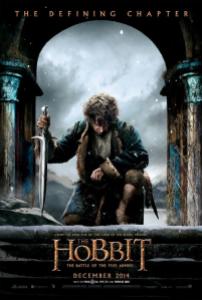 It’s all come down to this. We’ve arrived There and Back Again in the most epic trilogy ever put to film, yes? “The Hobbit” is such a dense and important story that it absolutely had to be spread out across three films. Surely one movie is not good enough for one book? If so, is “The Battle of the Five Armies” the monumental finale you’ve been waiting for? Are you not entertained?
It’s all come down to this. We’ve arrived There and Back Again in the most epic trilogy ever put to film, yes? “The Hobbit” is such a dense and important story that it absolutely had to be spread out across three films. Surely one movie is not good enough for one book? If so, is “The Battle of the Five Armies” the monumental finale you’ve been waiting for? Are you not entertained?
Peter Jackson’s “Hobbit” franchise has been the most lumbering, ponderous, self-important and at the same time eye-rollingly lame collection of films. “An Unexpected Journey” was laughably cartoonish, featuring dwarf singing, trolls scratching their asses and a goblin with a scrotum dangling from his chin. “The Desolation of Smaug” was frustratingly pointless, both so over-plotted in exposition and yet under-plotted in creating a story with actual substance. And each film, shot in 3D and high frequency 48 Frames Per Second, has looked awful: fake, too bright, and plain un-cinematic.
Was there a question that “The Battle of the Five Armies” would turn this around? This third entry may be the least bad in the franchise, but now it is drowning in portentous overtones of war, conflict and impending doom on the horizon. Jackson continues to underutilize his main character, i.e. the actual Hobbit in “The Hobbit”, and loses focus on elves, orcs, dwarves and weasel humans who won’t die or disappear. It’s as overstuffed a film as any of the previous, and it’s oh so long.
“The Desolation of Smaug” ended on an unfortunate cliffhanger, with the dragon Smaug being unleashed from his mountain lair by the clan of dwarves, only to be set loose upon the simple human city of Laketown. That’s where “The Battle of the Five Armies” picks up, but it’s a perplexing way to start the film. Not only does the abrupt opening lose its suspense and excitement, Jackson can’t pull himself away from the many human characters making their escape, including the insufferable comic relief Alfrid, the snively coward of a human always inserting himself into otherwise serious sequences.
Even once the dragon is slayed things don’t quite get moving. Jackson then jumps away to provide a teaser to the original “Lord of the Rings” trilogy, a distraction that’s little more than fan service in which Gandalf (Ian McKellen), Galadriel and Saurumon battle holograms of I’m not sure what.
What their meeting does explain is that now that Smaug has been slayed, all of Middle Earth will be coming to the mountain to claim the riches inside and its militaristically strategic location. As a result, the dwarves have barricaded themselves inside, still looking for the priceless stone that serves as a symbol for a leader’s rise to power. Bilbo (Martin Freeman) found it at the end of “The Desolation of Smaug” but now is reluctant to turn it over to Thorin (Richard Armitage) after seeing how the pursuit of it has driven him mad with power.
But the bluster Jackson musters seems misplaced. Thorin is king of nothing and these dozen dwarves amid five armies of thousands of elves, humans, and orcs seem to amount to a hill of beans. Yet still they chatter on endlessly about war, and only Bilbo avoids speaking his dialogue with an air of self-importance. One still wishes the film were about Bilbo and his growth more so than the MacGuffins and the gigantic battles.
Just like his plot exposition, Jackson has taken orchestrating CGI mayhem to a new level. Legolas (Orlando Bloom) executes a stunt here so laughably impossible that it’s plain brilliant on Jackson’s part. Legolas has knocked over a tower to create a makeshift bridge positioned perfectly between two mountain cliffs. In a fight with an orc leader atop it, it all starts to slowly collapse. Legolas then bounds (or perhaps glides is more accurate) up one stone at a time, each falling in a stepping stone pattern, which gives him enough time to jump on top of his opponent, then to safety, leading the orc to fall to his doom.
An isolated sequence like that, however absurd, is an example of the creativity Jackson still has and his ability to create a memorable moment of action filmmaking. I attest that out of all nine hours of footage across three movies, there is one truly great “Hobbit” film to be seen here. For how bloated and long this last installment continues to grow, “The Battle of the Five Armies” is not it.
2 ½ stars